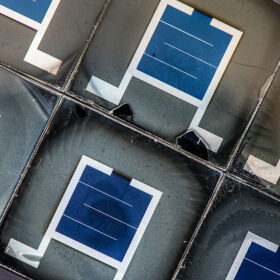U.S.-made perovskite-silicon tandem solar modules could be produced at around $0.35/W
Techno-economic analysis conducted by NREL researchers has shown how perovskite-silicon tandem solar modules could currently hardly compete in cost with incumbent PV panels. Production costs for U.S.-made tandem products were found to range between $0.29/W and $0.42/W, with module efficiencies ranging from 25% to 30%.
Trina Solar sets world record for solar module efficiency at 25.44%
Trina Solar has set a world record for solar module efficiency at 25.44%, verified independently by the CalLab at Fraunhofer ISE.
Wardwizard Innovations partners C4V on battery cell development for its electric vehicles
Wardwizard Innovations & Mobility has partnered with New York-based lithium battery technology company C4V to develop battery cells for its electric vehicle portfolio.
New research sheds light on impact of sodium-induced degradation in heterojunction solar cells
University of New South Wales researchers investigated the impact of sodium-induced degradation in heterojunction solar cells under accelerated damp-heat testing. They considered three different types of sodium salts and identified the degradation mechanisms attributed to each contaminant.
Bifacial perovskite solar can achieve bifaciality of 90% when tilted at 20 degrees
IIT Bombay researchers have shown that bifacial perovskite solar cells can achieve a 2% higher power conversion efficiency with a tilt angle of 20 degrees. They also developed a bifacial perovskite solar cell for applications in both tandem or single-junction PV devices.
ABB to acquire Gamesa’s power electronics, storage business
ABB has agreed to purchase Gamesa’s power electronics and storage business, which produces doubly fed induction generator (DFIG) wind converters, industrial battery energy storage systems (BESS), and utility-scale solar inverters.
Five-year testing show PV façades perform better than expected
Researchers in the Netherlands have analyzed the performance of PV façades during the period 2018-2023 and have found that these system may generate more economic value than conventional rooftop PV systems. Their analysis was based on financial, technical and environmental metrics
Volta Energy unveils new solar generator for construction sites, pumps
Netherlands-based Volta Energy has launched a 15 kVA portable solar generator to provide offgrid power equipment for use on construction sites. The system includes solar panels, an inverter, battery, trailer, and a backup bio-diesel generator.
Improving solar cell efficiency with upconversion nanoparticles
An international research group has developed a light upconversion system that can reportedly improve crystalline silicon solar cell efficiency by up to 0.87%. The technology consists of multilayer nanoparticles that act as near-infrared absorbers across different spectral ranges.
Mercedes-Benz testing new solar paint
Mercedes-Benz said it is now evaluating a 20%-efficient, non-silicon photovoltaic coating that is significantly cheaper than conventional solar modules.














